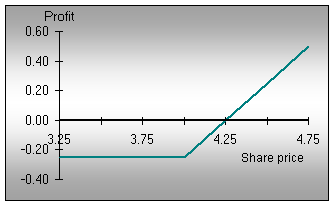Long call
Where the investor expects the price of the underlying stock to rise, the bought call can provide leveraged exposure to the price rise. Buying a call also locks in a maximum purchase price for the life of the option
Long call
Where the investor expects the price of the underlying stock to rise, the bought call can provide leveraged exposure to the price rise. Buying a call also locks in a maximum purchase price for the life of the option
| Market outlook | Bullish |
| Volatility outlook | Rising |

| The long call | |
| Construction | long call X |
| Point of entry | market around X, but can vary |
| Breakeven at expiry | strike price + net premium paid |
| Maximum profit at expiry | unlimited |
| Maximum loss at expiry | limited to premium paid |
| Time decay | hurts |
| Margins to be paid? | no |
| Synthetic equivalent | long stock, long put X |
The maximum loss the investor can suffer is the premium paid for the option, which will occur if the share price at expiry is below the strike price. The investor breaks even if at expiry the share price is equal to the strike price of the option plus the premium paid. As the share price rises beyond this point, the potential profits of the bought call are unlimited.
If the share price rise takes place as expected, the call option taker must decide whether to close out at a profit, or maintain the position in the hope of a further increase in price. The longer the option position is left open, the greater the effect of time decay.
If the share price does not rise as expected, it is often advisable to close out the position in order to recover some time value from the position.
If at expiry the option is in-the-money, the investor must choose whether to sell the option or exercise it. The choice will be determined by whether the investor wants to own the underlying shares.
After trading in a narrow range for several months, XYZ Limited has broken through a chart resistance point. You believe the share price will run up from current levels of $4.00 to $4.50 or more over the next two months. You decide to buy an at-the-money call option.
Buy 1 Nov $4.00 Call @ $0.25

Both courses have 10 modules with each module taking 20-25 minutes to complete
Options are flexible tools that appeal to active investors. Take this course to learn how to magnify profits or protect your portfolio by buying or selling options.
Disclaimer
The information contained in this webpage is for educational purposes only and does not constitute financial product advice. ASX does not represent or warrant that the information is complete or accurate. You should consider obtaining independent advice before making any financial decisions. To the extent permitted by law, no responsibility for any loss arising in any way (including by way of negligence) from anyone acting or refraining from acting as a result of this material is accepted by ASX.